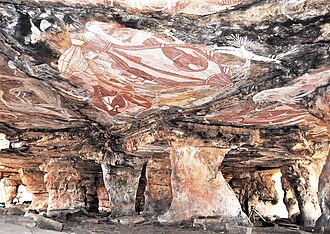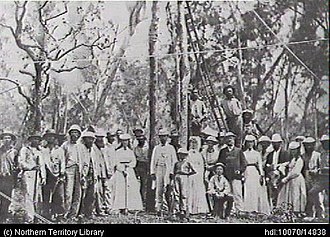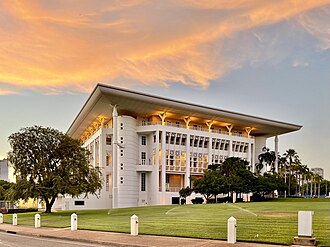From the tropical north to the dry red centre, the Northern Territory is one of the most diverse localities in Australia. There are over 100 nationalities and around 140 social, cultural and religious organisations active in the NT, as well as a strong and diverse Aboriginal community working to recover, revitalise and celebrate their ancient culture.
The Northern Territory is one of two territories and six states of Australia. As the name suggests, It is located in the north of the country, but extends down into the central part of the coninent. Initially administered as part of NSW the territory was annexed by South Australia by letters patent in 1863. It remained as part of South Australia, even after Federation in 1901.
In 1911, administration of the Northern Territory was transferred to Australian government control, under the South Australian Northern Territory Surrender Act 1907, and the federal Northern Territory Acceptance Act 1910. For a short period between 1926 and 1931, the Northern Territory was further divided into North Australia and Central Australia at the 20th parallel south of latitude..
In the 2021 Census, Northern Territory had an enumerated population of over 233,000 people, of which over 26% recognise as Indigenous Australians. The capital of Northern Territory is Darwin, home to over 140,000 people[1].
Research your ancestors on MyHeritage
History of Northern TerritoryHistory of Northern Territory
Indigenous HistoryIndigenous History

There is extensive archeological and cultural evidence attesting to the millennia long human habitation of Australia’s north. 60,000 years ago the sea level was considerably lower and Northern Australia and Papua New Guinea were connected by dry land. Humans migrated across this land bridge and down into the interior of the country.
Madjedbebe is the oldest known site showing the presence of humans in Australia. Archaeological excavations conducted by Clarkson et al. (2017) yielded evidence to suggest that Madjedbebe was first occupied by humans possibly by 65,000 +/- 6,000 years ago and at least by 50,000 years ago. [2]
Hundreds of years before Europeans mapped the continent, traders from islands to the north of Australia began trading with the residents of Arnhem Land and the Torres Straight Islands.
First the Baijini sea gypsy families came to trade for pearls and for oyster and turtle shell. The Baijini brought their entire families and built houses of stone and ironbark. They planted rice in Warrimiri country and Gumatj country. Later the people who traded out of Makassar (now Ujung Pandang) came in search of trepang, which was prized for its culinary and medicinal values in Chinese markets. The Makassar came only to collect trepang, never setting up permanent camps with crops, apart from dropped tamarind seeds that sprouted.[3]
Thousands of examples of rock art can be found across the Northern Territory. These drawings tell the stories of the first peoples of Australia, the direct forebears of indigenous people in the region today. This rock art clearly records the history of contact.
Historians have identified three distinct phases of art: pre-estuarine art, which depicts a dry climate and extinct animals, the estuarine period, showing rising sea levels and marine fauna, and a freshwater period, whch highlights freshwater fauna, and includes examples of 'historical' subjects such as the ships of the Makassan traders, and European technology like guns.[3]
There are over 100 different indigenous language groups in the Northern Territory including Warlpiri, which is spoken in Katherine, Tennant Creek and Alice Springs, Pitjantjatjara, a Western Deserts language spoken in Alice Springs, and Yolngu Matha, spoken in Yolgnu country in the top end.
European SettlementEuropean Settlement
The first recorded sighting of the Northern Territory coastline was by Dutch navigator Willem Janszoon aboard the ship Duyfken in 1606. Abel Tasman and numerous French navigators also charted the coast, naming many prominent features. Captain Phillip Parker King also made surveys of the coast.

Following British settlement in New South Wales in 1788, four unsuccessful attempts were made to settle coastal areas of the Northern Territory.
- In 1824, British Captain James John Gordon Bremer established Fort Dundas on Melville Island, but the settlement was abandoned in 1828.
- A second settlement, Fort Wellington, was established by Captain James Stirling on the Cobourg Peninsula at Raffles Bay in 1827, but it was also abandoned by 1829.
- A third attempt was made in 1838, with the establishment of Fort Victoria at Port Essington. The Prussian naturalist and explorer Ludwig Leichhardt, travelled from Moreton Bay, overland to Port Essington. An unsuccessful migration scheme was tried, and the first Catholic priest, Father Angelo Confalonieri, arrived in the area in 1846. However, the settlement disbanded on 1 December 1849.
In 1862, John McDouall Stuart succeeded in traversing Central Australia from south to north. His expedition mapped out the route which was later followed by the Australian Overland Telegraph Line. Stuart wanted the newly discovered region to be called "Alexandra Land", in honour of the Princess of Wales. The name was gazetted in 1865 applying to the portion South of 16°S of what is now the Northern Territory.
In 1863, the Northern Territory was annexed by South Australia by letters patent. Following the annexation, a fourth attempt at settlement occurred in 1864 at Escape Cliffs, about 75 km (47 mi) from present-day Darwin.

On 5 February 1869, George Goyder, the Surveyor-General of South Australia, established a small settlement of 135 men and women at Port Darwin. Goyder named the settlement Palmerston, after the British Prime Minister Lord Palmerston. In 1870, the first poles for the Overland Telegraph were erected in Darwin.
The construction of the Overland Telegraph, connecting Australia to the rest of the world, led to more exploration of the interior of the Territory. In 1872, Ernest Giles sighted Kata Tjuta from a location near Kings Canyon, naming it Mount Olga for Queen Olga of Württemberg, and in the following year, William Gosse observed Uluru and named it Ayers Rock, in honour of the Premier of South Australia Sir Henry Ayers.
The discovery of gold at Pine Creek in the 1880s drove further economic development.[3]
Post FederationPost Federation
For the first decade after Federation in 1901, the Northern Territory and Central Australia remained part of South Australia. In 1911 control was passed to the Commonwealth Government, with the passage of the South Australian Northern Territory Surrender Act 1907, and the federal Northern Territory Acceptance Act 1910.
Lots of people disliked the name Northern Territory, with alternatives such as Kingsland, for King George III and as a counterpoint to Queensland, Centralia and Territoria floated as alternatives. While Kingsland was a popular choice in 1913, a name change referendum was never put to the public.
The region was home to a large number of nomadic indigenous clan groups and so large swathes of land were set aside as Aboriginal Reserves, but the scale of these reserves was cut back in the 1940s to open the area up to more gold prospecting. Tourism also became more popular, especially to Ayer’s Rock/ Uluru.

During WWII Australia fought alongside the UK, the US and Europe to defend democracy. On February 19, 1942 Japanese aircraft bombed Darwin. Over the next 19 months Darwin was hit over 100 times.
The movement towards Aboriginal land rights in Australia began in the Northern Territory. For decades indigenous people had been exploited as cheap labor, paid only in food, clothing and accommodation that was more often than not inadequate.
In 1953 all First Nations peoples in the Northern Territory were made wards of the state and in 1959 the Wards Employment Regulations set out a scale of wages, rations and conditions applicable to wards employed in various industries. [4]
Wave Hill Station was owned by international meat packing company Vestey Brothers. But the wages paid to Aboriginal workers was often half that paid to white workers. Vestey Brothers refused to pay wages at all.
On 23 August 1966, 200 Gurindji stockmen, domestic workers and their families initiated strike action at Wave Hill station in the Northern Territory. … In April 1967 the Gurindji moved their camp 20 kilometres to Daguragu (Wattie Creek). This was a symbolic shift away from the cattle station and closer to the community’s sacred sites. [5]…
Led by Vincent Lingiari, the Gurindji drafted a petition to Governor-General Lord Casey asking him to grant a lease of 1,300 square kilometres around Daguragu. A key statement in the document was, ‘We feel that morally the land is ours and should be returned to us’. The Governor General replied he was unwilling to grant the lease.
The community continued to send requests and petitions to the Territory and Federal Government to no avail. But in 1972, Labor leader Gough Whitlam was elected Prime Minister on a platform to establish indigenous rights to land.
In March 1973 the original Wave Hill lease was surrendered and two new leases were issued: one to the traditional owners through their Murramulla Gurindji Company and another to Vestey Brothers. … In August 1975 Prime Minister Whitlam came to Daguragu and ceremonially returned a small portion of Gurindji land to the traditional owners by pouring a handful of soil into Vincent Lingiari’s hand with the words, ‘Vincent Lingiari, I solemnly hand to you these deeds as proof, in Australian law, that these lands belong to the Gurindji people’.[5]
Aboriginal Land Rights (Northern Territory) Act 1976 (The Land Rights Act) was passed by the Australian Parliament in December 1976 after years of political struggle by Aboriginal people to have their rights to land recognised. … This important and historic law recognises the Aboriginal system of land ownership by Traditional Land Owners and provides ways for them to own, control and use the resources of their land.[6]
Government of the Northern TerritoryGovernment of the Northern Territory
Australia has 3 levels of government - Federal, State and Local.
The Federal government is responsible for issues that effect all Australians, including national communications (post, telephony and the Internet), Defence, Immigration and foreign affairs.
The Northern Territory is one of two Territories. The Territory government, a legislative assembly, is responsible for issues that affect people within its boundaries - such as schools, hospitals and public transport.
Between 1863 and 1911 the area now known as the Northern Territory was annexed by South Australia. In 1911 the Northern Territory was transferred to the Commonwealth government and placed under the direct control of the federal Minister for External Affairs. The population of over 3000 people had no parliamentary representation or voting rights.

In 1922 the Northern Territory was granted one representative in the House of Representatives. In 1947, Territorians were granted the right to a Legislative Council, with six directly elected members and seven members appointed by the Administrator for the Northern Territory.
Finally, in 1978, the Northern Territory was granted responsible government, with a Legislative Assembly headed by a Chief Minister, publishing official notices in its own Government Gazette.
Local Councils are responsible for issues that relate to a local area - sometimes referred to as the 3-Rs - Roads, Rubbish and Recreation. [7].
All three levels of government maintain archives useful for family history research.
Demographics of The Northern TerritoryDemographics of The Northern Territory
Around 22% of the Northern Territory's residents were born in overseas, but the largest demographic group in the Northern Territory is indigenous people. The 2021 Census included a question on ancestral background. The top ancestral backgrounds in the Northern Territory are:
- Australian Aboriginal 24.5%
- Australian (non indigenous) 24.1%
- English 23.1%
- Irish 7.3%
- Scottish 6.3%
In 2021, the top five countries of birth in the NT were:
- Australia 69.5%
- Philippines 2.7%
- England 2.2%
- India 2.2%
- New Zealand 1.7%
After English the most common languages used were Kriol (2.2%), Djambarrpuyngu (1.7%), Greek (1.4%) and Nepali (1.3%)[8].
Most Popular Surnames in The Northern TerritoryMost Popular Surnames in The Northern Territory
Researching family history in The Northern TerritoryResearching family history in The Northern Territory
Records relevant to family history research can be found in collections at a national, state and local level. As a British colony, some very early records may also be found in The National Archives in the UK.
The primary sources for genealogical records in South Australia are Government agencies, archives and libraries.
Unfortunately there is no online, searchable index for Births, Marriage or Death records for the Northern Territory. Individuals can request a search and order certificates for a fee from the Northern Territory Registry of Births Deaths & Marriages.
The State Records of The Northern Territory are held by Library & Archives NT (LANT). There are a range of collections and search options including:
- Territory Stories, which provides an intuitive interface to search the NT holdings for digital photographs, archival items, newspapers, books, maps, periodicals and collection and research guides about the Northern Territory, and download selected content;
- an Oral History Search, which allows you to search abstracts of oral history interviews, including summary and content listings. You can search the index by name, topic, place or event. If you find an oral history you would like to listen to you can order a copy via the copying service (fees may apply)
- the catalogue where you can search their collection, and the catalogues of other collecting institutions in Australia and worldwide. The catalogue includes information about items in our collection including books, periodicals, maps, AV material, Personal and Community Archives and digital legal deposit items. Some of these items can also be accessed via Trove.
And of course, LANT has a comprehensive guide to Personal and Family History Research.
Trove, managed by the National Library of Australia (NLA), is an extraordinary free resource that aggregates content, including digitised newspapers, magazines, images, diaries and letters, and other material, dating from the establishment of the colony, from collections around Australia. Military Archives from around the country are predominantly held at the Australian War Memorial (AWM). The collection includes millions of items relating to individuals, units and conflicts, including digitised service records.
In regional areas and small country towns, local history and genealogical societies are a great source of local records. Many regional towns in NSW have a local history society, and/or a local library and museum. The Federation of Australian Historical Societies has a searchable index where you can find contact details for a society in a specific town or locality, or simply do a web search for the town name plus historical society.
Search MyHeritage for records from The Northern TerritorySearch MyHeritage for records from The Northern Territory
Research your ancestors on MyHeritage
See alsoSee also
Explore more about the Northern TerritoryExplore more about the Northern Territory
- Australian Handbook 1889 record collection at MyHeritage
- Trove: An Australian and Beyond Genealogical Treasure webinar at Legacy Family Tree Webinars
- Northern Territory Registry of Births Deaths & Marriages
References
- ↑ "Snapshot of Northern Territory, Australian Bureau of Statistics". www.abs.gov.au. Tue, 28/06/2022 - 10:00. Retrieved 2024-09-04.
{{cite web}}: Check date values in:|date=(help) - ↑ Wikipedia - Madjedbebe
- ↑ 3.0 3.1 3.2 Wikipedia - History of the Northern Territory
- ↑ corporateName=National Museum of Australia; address=Lawson Crescent, Acton Peninsula. "National Museum of Australia - Wave Hill Walk-Off". www.nma.gov.au. Retrieved 2024-09-19.
{{cite web}}: CS1 maint: multiple names: authors list (link) - ↑ 5.0 5.1 corporateName=National Museum of Australia; address=Lawson Crescent, Acton Peninsula. "National Museum of Australia - Wave Hill Walk-Off". www.nma.gov.au. Retrieved 2024-09-19.
{{cite web}}: CS1 maint: multiple names: authors list (link) - ↑ captovate (2017-07-11). "The Aboriginal Land Rights Act". Office of Township Leasing. Retrieved 2024-09-19.
- ↑ "The responsibilities of the three levels of government - Parliamentary Education Office". peo.gov.au. Retrieved 2024-09-04.
- ↑ "Snapshot of Northern Territory | Australian Bureau of Statistics". www.abs.gov.au. Tue, 28/06/2022 - 10:00. Retrieved 2024-09-04.
{{cite web}}: Check date values in:|date=(help)


